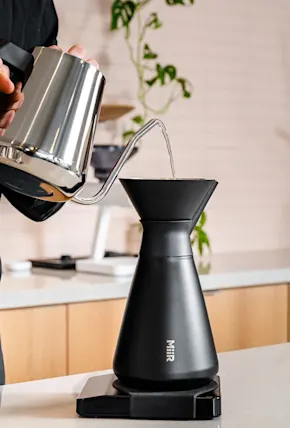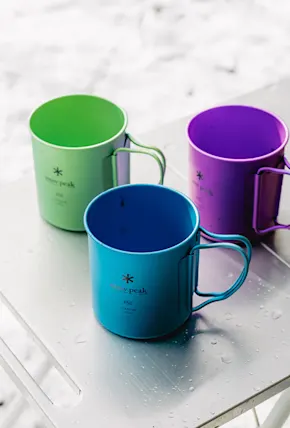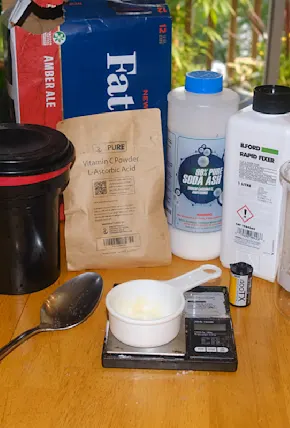A very solid camp coffee choice, Alpine Start is directly marketed towards us outdoor folk who prefer to leave the camping coffee maker at home. Their hero product, good old instant coffee, is available in both jar and individual packets and is made with 100% Colombian Arabica coffee beans. And if coffee isn’t for you, check out their mushroom-infused instant matcha, which we enjoy at FM HQ as an afternoon pick-me-up.
(Use code "FIELDMAG" at checkout to get 10% off your order.)
Price: $9 per 8 pack
SHOP NOW
A San Francisco mainstay, Equator is well known for expertly roasted coffees, and their instant coffee offering lives up to that reputation. With great flavor and plenty of kick, a morning cup of Equator will please even discerning coffee drinkers with its delicious balance of acidity and coffee flavor. Equator is another go-to for us, especially when we want specialty coffee. (You can brew it cold too, if you're running low on cold brew.)
Price: $15 per 5 pack
SHOP NOW
Wildland Coffee is a newer instant coffee brand and, technically, it isn't instant coffee—it's just coffee. The whole beans it uses are sourced from Brazil, ground, then nitro-flushed for freshness longevity. And unlike instant coffee poweder, it comes in a teabag—just heat up some water and steep for eight minutes and your cup of joe is good to go.
Price: $23 per 10 pack
SHOP NOW
Based in Missoula, Montana, this hometown hero brand sources organic coffee beans grown around the globe. As a small, family run business, they've poured all their R&D into making just a single, dang fine instant coffee with just the right caffeine content to get you ready for a day of hiking, paddling, or lounging around camp.
Price: $13 per 8 pack
SHOP NOW
Fancy packaging doesn't always make a fancy product, but in Verve’s case, it does. And by that we mean, it makes a really good product. Based in Santa Cruz, California, Verve is a real specialty coffee maker that cares about quality. Its Farmlevel Initiative, for example, entails partnering with farmers in Colombia and elsewhere to ensure their livelihood is secure. The result of it all is coffee you can count on.
Price: $16 per 6 pack
SHOP NOW
Made in Lancaster, PA, Swift is purely focused on specialty instant coffee. Order their three box sets to sample a variety, or opt for the bulk option which packs 48 cups of instant coffee into a single jar.
Price: $11+ per 6 pack
SHOP NOW
Supr is another new brand exclusively offering specialty instant coffees. While their regular instant coffee sticks are worth a taste for sure, their instant coffee with CBD is another intersting, and perhaps counterintuitive choice. But who wouldn't want a buzz sans jitters?
Price: $15 per 10 pack
SHOP NOW
If you’re attached to your pour-over ceremony each morning, Allawake is for you. These little pour-over coffee kits may not be instant but they are single serving. A bit bulky for backpacking, but nice for an elevated coffee experience while car camping or just traveling in general.
Price: $13+ per 5 pack
SHOP NOW
Another handy pour-over packet, Kuju is an outdoors-focused coffee maker that's earned trust among outdoorists while maintaining a dedication toward coffee culture. Its high-quality line of light, medium, and dark roast instant coffee beats the Nescafé Clásico you'll find at the grocery store any day, and Kuju also produces a line of single-origin coffee that comes from Ethiopia, Papua New Guinea, and West Sumatra.
Price: $15 per 6 pack
SHOP NOW
What Starbucks Via lacks in taste, it makes up for in accessibility and affordability. It's arguably burnt and generally not great, but it's also extremely reliable, available everywhere from gas stations and super markets to actual Starbucks cafes, and of course, has caffeine so it'll do just fine in a pinch.
Price: $7 per 8 pack
SHOP NOW
This newly launched, woman-owned coffee brand is determined to reimagine the power of decaf. Their “uncaf” coffee packets are made with prebiotics, antioxidants, anti-inflammatories, and spices for a rich, velvety, crash-proof cup. Tasting notes are buttery and smooth with a hint of sweet chocolate.
Price: $28 per 8 pack
SHOP NOW
OK, so by now you know which coffee you want to try. But that still leaves the curious question of how said coffee is actually made. Below, we'll dive into the actual process of making instant coffee. Plus share some advice on how to make it taste even better.
How Is Instant Coffee Made?
Instant coffee is made from whole coffee beans that are roasted, ground, and brewed. The water is then removed from the brewed coffee, leaving dehydrated crystals. There are a couple different methods used to make instant coffee blends, but they all start off with this same process of removing moisture from the brewed coffee extract to create solid coffee powder, or granules, behind.
One of the most common ways that moisture is removed from the coffee extract is through spray-drying, why sounds a bit like an oxymoron but here us out. The liquid is sprayed into a stream of scorching air, causing the liquid to evaporate, and the coffee to drift down in a powder form. Sometimes this powder goes through an additional process to form it into granules. Because the extract dries very quickly during the spray-drying process, much of the aroma and flavor is preserved.
Another way to remove the moisture is by freeze-drying the coffee extract. In this process the extract is frozen at around -40°F and broken into crystals. These are then slowly dried using low heat in a vacuum. The low temperatures and slow drying process lock in the flavor in freeze dried coffee.
Making decaffeinated coffee involves a few more steps before the roasting process. First, green coffee beans are swollen either by steam or by being soaked in water. More water, a solvent, or activated carbon is then used to extract the caffeine before drying the beans again. Instant decaf coffee will then follow the normal spray-dry or freeze-dry processes.






















